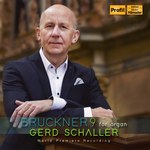|
Back
03/24/2021
“Bruckner 9 for organ”
Anton Bruckner: Symphony n° 9 in D minor, WAB 109 (unf.) (arr. for organ – fourth movement arr. G. Schaller)
Gerd Schaller (organ)
Recording: Cistercian Abbey Church, Ebrach, Germany (November 2-5, 2020) (World Premiere Recording) – 87’17
2 CDs Profil PH21010 (Distributed by Naxos of America) – Booklet in German and English

   
When the bicentennial of Anton Bruckner’s birth takes place in 2024, Gerd Schaller will be ready to celebrate. The German conductor, musician and arranger is aiming to record all of Bruckner’s major works and has taken no small step toward this goal in a new arrangement for organ of Bruckner’s Symphony n° 9 in D minor. In this version, Schaller has constructed a fourth movement from the abundant notes left behind at the composer’s death in 1896.
At first glance, the thought of a Bruckner symphony transcribed for the organ does not sound like a good idea. Many Bruckner enthusiasts came to love the master because of his lush orchestrations, his ability to build symphonic forces to almost unendurable heights of power and majesty, and for some, the greatest music for brass ever composed.
These reasons constituted a formidable chip on my shoulder as I began listening to this recording. But about halfway through the first movement, I began to appreciate the virtues of this transcription especially as so nobly performed by Schaller on the Ebrach/Eisenbarth organ of the former Cistercian Abbey Church of Ebrach.
The organ was the instrument Bruckner played all his life, performing in small churches in the Austrian countryside and returning as organist to the Augustinian Abbey of St. Florian where, as a boy, he sang in the choir. I’ve been privileged twice to visit this beautiful Baroque monastery, hear the Bruckner organ and visit his sarcophagus in the crypt, but to know the essence of Bruckner, one need only seek out fine recordings and listen with an open mind.
With some help from an exceptional interview of Schaller by Andrea Braun in the accompanying booklet, I began to let go of my biases and enjoy this splendid album on its own merits. The booklet provides detailed, well written accounts of the history of the Ebrach organ and its suitability for Bruckner’s unique compositional style as well as an explanation as to why the conductor chose to arrange a symphonic work for organ (“I wanted to understand Bruckner even better, come to grips with the architecture of his symphonic thought.”)
Among the impressions gathered in the first movement was the modernity and clarity of the sound. The organ revealed harmonic subtleties hidden in the instrumental diversity of the orchestral original. Perhaps it was my attitude, but I felt the movement could have been more Romantic, more sweeping in its grandeur, a state it actually did achieve by the movement’s end. Schaller certainly is a master musician and draws on the instrument’s many resources to express rather than to imitate orchestral sounds.
The second movement, with its monotonic rattle, had a minimalist quality that again was surprisingly contemporary. By the third movement, I was won over by Schaller’s creativity and by the clean, pleasing way the bones of the symphony were positioned for optimum suppleness and vitality. I was truly surprised at the number and volume of grating discords near the end of this movement. They seem dissipated somehow when played by the instruments of the orchestra, but wild and dangerous out in the open, with no place to hide.
The fourth movement, based on Bruckner’s detailed sketches, starts playfully and moves into a series of crescendos and diminuendos, sweeping into that Romantic majesty I yearned for in movement one. Schaller ends his vision of Bruckner with a luxurious blend of infinitely dark, sinking low notes, suddenly climbing to ever-rising rays of golden high notes and a crash of major chords, quite Wagnerian.
What a delightful way to conclude the final chapter in a series of nine symphonies that sing like one unified musical statement. This album is a valuable part of Schaller’s BRUCKNER2024 recording project and promises to bring education, delight, and pure beauty to lovers of Bruckner and music in its many guises for years to come.
Linda Holt
|